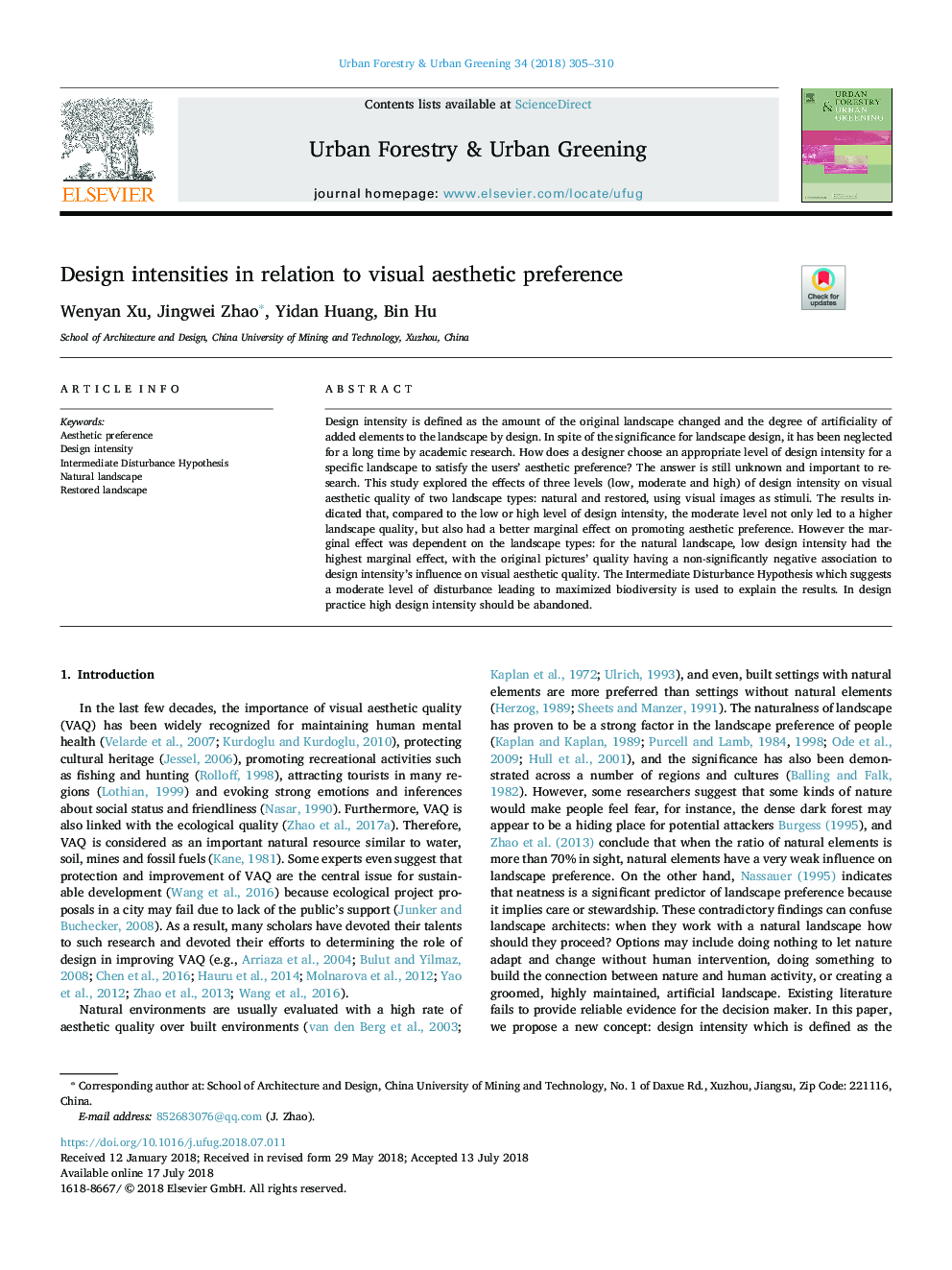| کد مقاله | کد نشریه | سال انتشار | مقاله انگلیسی | نسخه تمام متن |
|---|---|---|---|---|
| 6549103 | 1421856 | 2018 | 6 صفحه PDF | دانلود رایگان |
عنوان انگلیسی مقاله ISI
Design intensities in relation to visual aesthetic preference
ترجمه فارسی عنوان
شدت طراحی با توجه به ترجیح زیبایی شناسی بصری
دانلود مقاله + سفارش ترجمه
دانلود مقاله ISI انگلیسی
رایگان برای ایرانیان
کلمات کلیدی
ترجیح زیبایی شدت طراحی، فرضیه اختلال متوسط چشم انداز طبیعی، چشم انداز بازسازی شده،
ترجمه چکیده
شدت طراحی به عنوان مقدار چشم انداز اصلی تغییر و درجه مصنوعی عناصر اضافه شده به منظره با طراحی تعریف شده است. به رغم اهمیت طراحی چشم انداز، به مدت طولانی توسط پژوهش های علمی صرف نظر شده است. طراح چگونه یک سطح مناسب از شدت طراحی برای یک منظره خاص را برای ارزیابی اولویت های زیباشناختی کاربران انتخاب می کند؟ پاسخ هنوز برای تحقیق ناشناخته و مهم است. این مطالعه به بررسی اثرات سه سطح (کم، متوسط و شدید) شدت طراحی بر کیفیت زیبای بصری دو نوع منظره اشاره می کند: طبیعی و بازسازی شده، با استفاده از تصاویر بصری به عنوان محرک ها. نتایج نشان می دهد که در مقایسه با سطح پایین یا شدت طراحی شدت، سطح متوسط نه تنها کیفیت چشم انداز بالاتر را افزایش داد، بلکه تاثیر منفی بر ترجیح دادن زیبایی شناختی نیز داشت. با این حال اثر حاشیه ای به انواع چشم انداز وابسته بود: برای چشم انداز طبیعی، شدت طراحی پایین، دارای بیشترین اثر نهایی بود؛ کیفیت کیفیت تصاویر اصلی دارای یک رابطه منفی غیرمنطقی برای تأثیر طراحی شدت بر کیفیت زیبایی شناسی بصری بود. فرضیه اختلال متوسط که نشان می دهد سطح متوسط اختلال منجر به حداکثر تنوع زیستی می شود برای توضیح نتایج استفاده می شود. در تمرین طراحی باید شدت طراحی را رها کنید.
موضوعات مرتبط
علوم زیستی و بیوفناوری
علوم کشاورزی و بیولوژیک
جنگلداری
چکیده انگلیسی
Design intensity is defined as the amount of the original landscape changed and the degree of artificiality of added elements to the landscape by design. In spite of the significance for landscape design, it has been neglected for a long time by academic research. How does a designer choose an appropriate level of design intensity for a specific landscape to satisfy the users' aesthetic preference? The answer is still unknown and important to research. This study explored the effects of three levels (low, moderate and high) of design intensity on visual aesthetic quality of two landscape types: natural and restored, using visual images as stimuli. The results indicated that, compared to the low or high level of design intensity, the moderate level not only led to a higher landscape quality, but also had a better marginal effect on promoting aesthetic preference. However the marginal effect was dependent on the landscape types: for the natural landscape, low design intensity had the highest marginal effect, with the original pictures' quality having a non-significantly negative association to design intensity's influence on visual aesthetic quality. The Intermediate Disturbance Hypothesis which suggests a moderate level of disturbance leading to maximized biodiversity is used to explain the results. In design practice high design intensity should be abandoned.
ناشر
Database: Elsevier - ScienceDirect (ساینس دایرکت)
Journal: Urban Forestry & Urban Greening - Volume 34, August 2018, Pages 305-310
Journal: Urban Forestry & Urban Greening - Volume 34, August 2018, Pages 305-310
نویسندگان
Wenyan Xu, Jingwei Zhao, Yidan Huang, Bin Hu,
